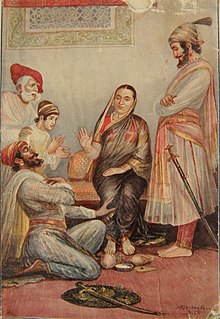Battle of Sinhagad: Difference between revisions
No edit summary Tags: Visual edit Mobile edit Mobile web edit |
No edit summary Tags: Visual edit Mobile edit Mobile web edit |
||
| Line 9: | Line 9: | ||
| date = 4 February 1670 |
| date = 4 February 1670 |
||
| place = Fort [[Sinhagad]], near [[Pune]], [[India]] |
| place = Fort [[Sinhagad]], near [[Pune]], [[India]] |
||
| result = Maratha victory<ref>{{Cite book |last=Sorokhaibam |first=Jeneet |title=Chhatrapati Shivaji: The Maratha Warrior and His Campaign |date=2013 |publisher=Vij Books India Private Limited |year=2013 |isbn=9789382573494 |publication-date=2013 |pages=185-187 |language=English}}</ref> |
|||
| result = Maratha victory |
|||
| territory = Fort [[Sinhagad]] captured by [[Marathas]] |
| territory = Fort [[Sinhagad]] (then, Kondhana fort) captured by [[Marathas]] |
||
| combatant1 = {{flagicon image|Flag of the Maratha Empire.png}} [[Maratha Empire|Maratha kingdom]] |
| combatant1 = {{flagicon image|Flag of the Maratha Empire.png}} [[Maratha Empire|Maratha kingdom]] |
||
| combatant2 = {{flagicon image|Flag of the Mughal Empire.png}} [[Mughal Empire]] |
| combatant2 = {{flagicon image|Flag of the Mughal Empire.png}} [[Mughal Empire]] |
||
| commander1 = [[File:Flag of the Maratha Empire.svg|border|22px]] [[Tanaji Malusare]] {{KIA}} |
| commander1 = [[File:Flag of the Maratha Empire.svg|border|22px]] [[Tanaji Malusare]] {{KIA}} |
||
| commander2 = [[File:Alam of the Mughal Empire.svg|22px]] |
| commander2 = [[File:Alam of the Mughal Empire.svg|22px]]Udaybhan{{KIA}}<ref>{{cite book | url=https://books.google.com/books?id=iHK-BhVXOU4C&pg=PA79 | title=The Marathas 1600-1818 | isbn=978-0-521-03316-9 | last1=Gordon | first1=Stewart | date=February 2007 | publisher=Cambridge University Press }}</ref> |
||
| strength1 = 12,000 infantry |
| strength1 = 12,000 infantry |
||
| strength2 = Unknown |
| strength2 = Unknown |
||
Revision as of 12:44, 19 July 2024
| Battle of Sinhagad (Kondhana) | |||||||||
|---|---|---|---|---|---|---|---|---|---|
 The Fort of Sinhagad | |||||||||
| |||||||||
| Belligerents | |||||||||
|
|
| ||||||||
| Commanders and leaders | |||||||||
|
|
| ||||||||
| Strength | |||||||||
| 12,000 infantry | Unknown | ||||||||
The Battle of Sinhagad, also known as Battle of Kondhana, involved an attack by Marathas during the night of 4 February 1670 on the fort of Sinhagad (then Kondhana), near the city of Pune, Maharashtra. However, the Marathas captured the fort.
Background

In the 1650s, Aurangzeb sent Shaista Khan to subdue Shivaji. Khan captured Poona (now Pune) and took residence in Lal Mahal. Shivaji and his soldiers made a surprise attack on Khan, wherein they wounded him and killed one of his sons. However, Khan eventually escaped. Khan looted Pune for 2 years and devastated Deccan. So, Shivaji went on to loot and plunder the wealthy port city of Surat to restore the wealth as Surat at the time was a centre of great riches and wealthy merchants. This greatly increased Aurangzeb's anger against the Marathas. He sent his General Mirza Raja Jai Singh with a large army to subdue Shivaji. Jai Singh besieged Purandar fort. Meanwhile, Diler Khan defeated the armies at Vajragad, near Purandar. The Mughals plundered villages in the Maratha kingdom. For the welfare of his subjects, Shivaji decided to sign a treaty with Jai Singh. They met and signed the Treaty of Purandar. According to the treaty, Shivaji was to give 23 forts to the Mughals and agree to fight for them when needed. He would be allowed to retain control of 12 forts. Later, he agreed to meet Aurangzeb at Agra.[citation needed]
Upon reaching Agra, Aurangzeb put him under house arrest, but Shivaji managed to escape. Shivaji then kept a low profile for some years until Aurangzeb increased activities in the north. Later, Jai Singh died at Burhanpur, and a weaker prince, Muazzam, became governor of the Deccan. Shivaji then felt that this was a good opportunity to reclaim what had belonged to the Swarajya. He broke the treaty and started recapturing the forts that he had previously given the Mughals under the treaty.[citation needed]
Battle
Sinhagad was one of the first forts which Shivaji recaptured from the Mughals. The capture was made possible by scaling the walls at night with rope ladders. Tanaji Malusare was martyred, but the fort was captured by the Marathas. The battle and Tanaji's exploits are the basis of a popular Marathi ballad.[3]
Aftermath
When Chhatrapati Shivaji Maharaj was informed about the victory and the loss of Tanaji's life during the battle, he exclaimed "Gad aala pan sinh gela" (Devnagari: गड आला पण सिंह गेला) (English: "The fort has been captured but we lost the lion"). A bust of Tanaji Malusare was installed at the fort in memory of his contribution and sacrifice.[4] The fort was also renamed Sinhagad to honour his memory.[citation needed]
In popular culture
- Tanhaji - a Hindi movie of 2020, starring Ajay Devgan, depicted the battle of Kondhana.
- Raja Shivchatrapati - a Marathi TV serial of Star Pravah had episodes about this battle.
- Subhedar - a Marathi movie of 2023, starring Chinmay Mandlekar, depicted the battle of Kondhana
References
- ^ Sorokhaibam, Jeneet (2013). Chhatrapati Shivaji: The Maratha Warrior and His Campaign. Vij Books India Private Limited. pp. 185–187. ISBN 9789382573494.
{{cite book}}: CS1 maint: date and year (link) - ^ Gordon, Stewart (February 2007). The Marathas 1600-1818. Cambridge University Press. ISBN 978-0-521-03316-9.
- ^ Gordon, Stewart (1993). The Marathas 1600-1818. Vol. 2. Cambridge University Press. p. 79. ISBN 9780521033169.
The first and most spectacular success was the capture of Sinhagad fort. It was taken by scaling very difficult walls by the means of rope ladders in a night raid which culminated in a hand to hand combat inside the fort. The raid was led by Tanhaji Malsure, who was killed in the battle.
- ^ Verma, Amrit (2003). Forts of India. New Delhi: The Director, Publication Division, Ministry of Information and Broadcasting, Government of India. pp. 83–86. ISBN 81-230-1002-8.
